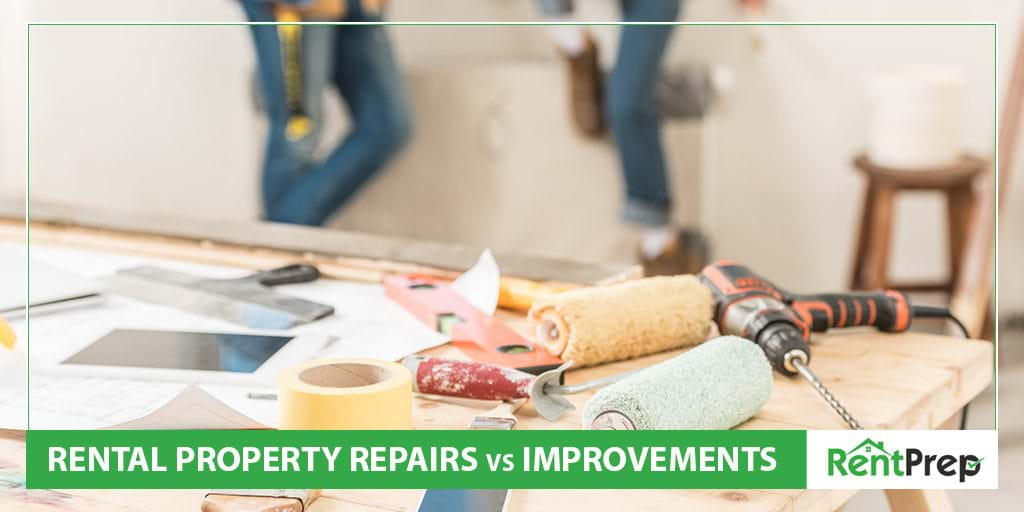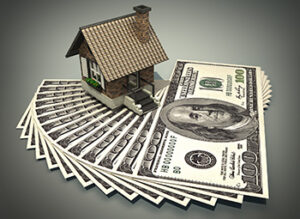
As a landlord, you’ve probably received a call when a tenant has told you there is a repair needed. These calls often come in the middle of the night, or when you’re trying to enjoy what little time off you have. Sometimes, the call will result in you as a landlord needing to make an urgent decision.
One thing about repairs, especially when they’re last minute, is they often cost quite a bit of money. This is why it’s crucial to know the difference between rental property repairs vs. improvements.
In an ideal world, everything we did to our properties, whether a repair or an improvement, could be written off come tax time. Unfortunately, that’s not the case. It can be confusing when you have to sort through what is a deduction and what’s not, which is why you should learn everything you need to know about repairs and improvements.
Something like a roof that leaks can be a deduction if you repair the leak, but if you decide to replace the entire roof, you’re not going to be able to deduct that all at the same time. Let’s talk about what is considered an improvement and what’s considered a repair.
A Table Of Contents For Rental Property Improvements Vs. Repairs
- What Are The Differences?
- Comparison Table
- Different Types Of Capital Expenses
- What Does The IRS Consider A Unit Of Property?
- Deducting On Your Taxes
- Conclusion
What Are The Differences?
Repairs
The best way to know when something is a repair is to ask yourself if what needs to be done is to make the property livable. Repairs often cost much less than improvements, usually below the $500 mark.
A repair can be anything from holes in the walls from nails, a clogged shower drain, or a leaky roof. These are costs you can easily deduct and fix without needing to break the bank. As long as a repair doesn’t increase the value of the property, the IRS won’t mind.
Improvements
An easy way to know if something is an improvement rather than a repair is whether or not it improves the value of the property. If it does, or in any way extends the life of the property, it is considered a capital expense.
This means it must be capitalized as a long-term asset and deducted over several years, instead of all at once. All you need to do is deduct small amounts each year and you’ll have a full deduction within a few years.
Improvements can be things like replacing the roof, creating a large garden out front for curb appeal, or in any way renovating the interior of your units. You may also want to know the difference between improvements and repairs for things that may be considered necessities like heating or air conditioning units. If you have to replace the entire system instead of just fixing it, it is considered an improvement. If you were to just need to fix a thing or two about the system, it would be a repair.
Improvements cost much more than repairs and usually take a lot longer to complete. Thus, adding or upgrading things to your property are usually considered improvements instead of repairs. Improvements tend to increase the value of your property over several years, which is why you can’t deduct the entire improvement or renovation in one year. One of the best things about improvements is that you can charge more rent for the unit and bring in more money.
Comparison Table
Below you’ll see a comparison table to give you a better idea of what the differences are between some of the more common improvements and repairs. To see a full list provided by the IRS, click here.
| Improvements | Repairs |
| Adding a structural addition | Fixing a cracked foundation |
| Installing a new air conditioning unit | Repairing an old air conditioning unit |
| Putting in a security system | Replacing a broken security camera |
| Installing new hardwood floors | Fixing a small patch of damaged flooring |
| Replacing the entire roof | Sealing a leaky roof |
| Putting in entirely new plumbing | Fixing a leaky faucet or broken pipe |
| Rewiring the entire property | Replacing a light fixture |
| Renovating an entire kitchen | Fixing a broken pantry door |
| Replacing the entire carpet | Replacing a small section of damaged carpet |
| Painting the entire apartment building | Painting a room or section of a wall |
| Buying new appliances | Fixing broken appliances |
| Replacing all the hardware on every door | Buying a new door knob for one door |
| Tiling the entire bathroom | Replacing a few tiles or fixing cracks |
| Replacing several windows | Fixing a window frame or adding in a new pane of glass |
Different Types Of Capital Expenses

When it comes to taxes as a landlord or a property owner, things can be complicated and overwhelming. The IRS will use several categories to help you define what is and what isn’t considered a capital expense.
By law, you have to capitalize and depreciate the things listed below.
Improvements
For starters, you have to capitalize any expense that improves your rental property. These improvements better the property and increase it’s overall value. Improvements can often be done to restore the property or changes your property in a way to follow different rules or uses. Something that could fall under this would be if you were to add a handicap ramp onto your property.
Betterments
If you have to fix a condition or current defect to your property, this is considered a betterment. Betterments can also be things like expanding your property or doing anything to improve the quality of the units you have. This could be something like adding on a car park for your tenants or restoring the outside of your building.
Adaptation
Adaptation is another thing that you have to claim with the IRS. These can be expenses that are used to change your property in a way that goes beyond its intended use. For example, if you have a house that you used to rent out to college students and now you want to turn the house into a coffee shop, this would be considered an adaptation.
Restoration
Lastly, there is restoration. Restoration has to do with replacing a large structural part of your property. This can be replacing old balconies and patios, paving a new parking lot, or replacing the windows on units. Restoration can also be applied to casualty loss, or if you’ve been wanting to rebuild your property to make it as new and up-to-date as possible.
What Does The IRS Consider A Unit Of Property?

It’s important to know what your property consists of to give you a better idea of whether or not you improved or repaired the rental. This can be a big difference, depending on how the unit of property is defined. The bigger the unit is, the more likely whatever work needs to be done is considered a repair, rather than an improvement.
Think of it this way: You have an apartment building with several units. If the building is defined as one single structure, you may be able to get away with claiming certain things as repairs rather than improvements because they’re much smaller in the grand scheme of a large building. Use fire escapes, for example; if you want to replace those on an apartment building, that may be a repair, but if you’re repairing them on a building where only the fire escapes are used, it would be an improvement.
The IRS has a lot of new regulations that require some buildings to be divided into several different units of property. So, you can have one single apartment building be described as nine different building systems according to the IRS standards. This makes it a lot harder to have repairs be considered as repairs, since it’s not considered one giant unit.
The Entire Building As One Unit Of Property
When an entire building is considered one single unit of property in the eyes of the IRS, you may need to know the structural components to help you differentiate between repairs and improvements. We’ve listed what the structural components for an entire building as one unit of property are below:
- Walls and partitions
- Floors and ceilings (including panelling and tiling)
- Windows
- Doors
- Air conditioning units
- Heating systems
- Plumbing and plumbing fixtures
- Wiring
- Lighting fixtures
- Chimneys
- Fire places
- Stairs and elevators
- Sprinkler systems and fire escapes
- Roofs
- Balconies
- Patios
Replacing any of the items listed above will most likely be considered an improvement.
Building Systems As Units Of Property
On the other hand, the IRS can consider a single property between two and nine building systems. If you improve any of the things listed below, you’ll need to depreciate them over time, instead of all at once.
Heating and air conditioning systems are a popular one, especially in states that have extreme seasons. This can be anything from vents to pipes to ducts to furnaces.
Another thing can be the plumbing system. This includes things like pipes, drains, sinks, showers, bathtubs, toilets, valves, sewer collection, and any equipment that is used to distribute either water or waste.
Electrical systems also play a large role when it comes to improvements. This can include things like the wiring, junction boxes, different lighting fixtures throughout the unit, outlets, connectors, and any on-site equipment that is used to bring in electricity.
Fire-protection and alarm systems that keep your tenants and property safe are another thing you want to be aware of. This can include a number of things, including the following:
- Devices
- Computer controls
- Sprinkler mains
- Sprinkler heads
- Piping
- Plumbing
- Audio alarms
- Visual alarms
- Control panels for alarms
- Smoke detectors
- CO2 detectors
- Fire escapes and doors
- Emergency exit signs
- Fire extinguishers
- Fire hoses
Depending on what type of building you have, security systems can also be on this list. This can include simple things like the locks on windows or doors, or more complex things like security cameras, motion detectors, alarm systems, entry systems, and any wiring related to these items.
Gas distribution systems that include things like pipes and other equipment to get gas from the lines to the building are also considered to be an improvement.
Lastly, any work done when it comes to replacing stairs, escalators, or elevators will be considered an improvement when you have building systems according to the IRS.
Deducting On Your Taxes
Deducting Improvements
As you’ve read, you can deduct improvements that you make to your properties; the catch is that you can’t deduct the entire value in one year. This is mainly because the improvement you make adds value over time, instead of all at once.
Because of this, you have to capitalize and depreciate improvements according to a set schedule, depending on the specific asset that was improved upon. You have to divide the cost of the improvement by how useful it will be over the years, then take an annual deduction based on the amount of years the improvement will be good for.
Deducting Repairs
When you’re making a repair, it’s being done to better something’s condition to make it usable. This means you can deduct the full amount it costs to repair it in one year. In some circumstances, there are losses that are incurred from repairs that can actually be carried over to other years.
Conclusion
Whether you’re a landlord or a property owner, it’s crucial to know the difference between a repair and an improvement. This can save you not only money, but also trouble from the IRS. Making sure you take every deduction you can will also help save you money.
You’ve read a bit of the differences between rental property repairs and improvements, but it can be hard to keep track of everything, especially if you have multiple properties. Consider reaching out to a professional tax advisor to help keep things sorted for you.

